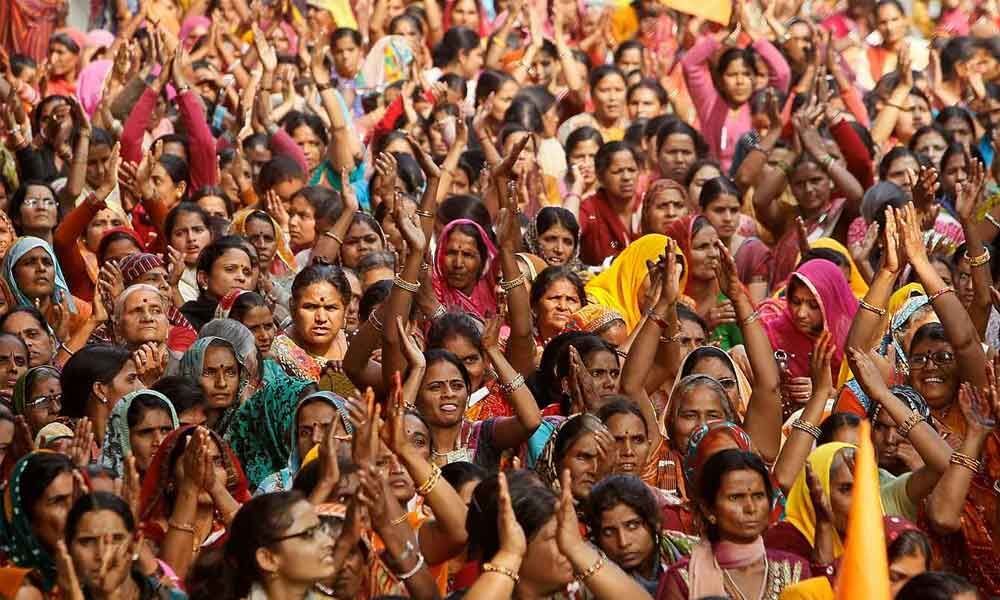Women need their share in politics too

Political battle cry has already been sounded. Leaders, strategists and rabble-rousers are burning their midnight's oil to get their slice of pie in the hustings.
Ironically this time around, none is speaking about the real issues plaguing crores of hapless common people, but hyper nationalism, surgical strikes, claims of space explorations and name-calling are ruling the roost.
Yes, it is election season now and everything revolves around the four-letter word - VOTE. Political parties are leaving no stone unturned to attain supremacy over their rivals and attract the attention of the electorate.
The leaders, who were unseen since the last general elections in 2014, have started descending in large numbers out of nowhere, claiming to be messiahs of the masses, heaping promises in leaps and bounds and seeking votes for their parties and candidates.
Vote builds a democracy and a constructive democracy takes us to achieve a desired goal. Democracy in India is of seven decades old.
As the country is going for general elections yet again, the electorate, that surpassed the population of many small countries, are all set to witness farces all sorts.
From a ballot system of democracy, our country progressed to a technologically advanced Electronic Voter Machine (EVM) system and that system too is now linked to a VVPAT pattern.
The baton of democracy is being carried by the political parties enrolled with the Election Commission, which is entrusted with the responsibility of protecting the altar of democracy.
Now, the real issue. Female voters outnumber their male counterparts in many constituencies in the country. However, a cursory glance at the electoral numbers of the country reveals that women are unable to show their presence according to their population ratio and as per the voter share in the electoral rolls.
Women have always been an important part of Indian politics but their participation in realpolitik is still not very impressive.
The underrepresentation of women in the Lok Sabha and other crucial decision-making bodies such as the Cabinet is pointer of their systematic exclusion from the political structure and the deeply-embedded gender bias in Indian society.
The number of women politicians is small as compared to men. The majority of women are indifferent to politics; this is clear in their low participation in voting, in public demonstration, and in public debates.
Between 1957 and 2015, the total number of women contestants in the general elections has increased from a mere 45 to 668. That is a whopping 15-fold increase in the number of women contesting in elections.
If we looked at the data of male contestants for the same years, the number has increased from 1,474 to 7,583, a five- fold increase. The 15-fold increase in the number of women contestants indicates the growing appetite of women to enter the political fray and their willingness to be part of political decision-making.
And if one observes the outcome of all these elections over the years, it is evident that women have had a greater success rate than men in every single election. In some years, the difference has been quite stark.
In 1971, the success rate for men was 18 percent, whereas it was 34 percent for women, which is twice that of men. For the current Lok Sabha, the success rate was 6.4 percent for men and 9.3 percent for women.
This could mean one of the two things: Either women had a greater chance of winning from the seats that they stood from or that tickets were being given to women who had a greater chance of success.
From the first general elections of 1952, the number of female winners in the Lok Sabha has been increasing. As per the available statistics, the first election in the country has sent 22 female MPs.
This number is in a total of 489 Parliament members. In 1957, a total of 27 female members were elected out of a total of 494 seats, in 1962, it increased to 34. The 1967 elections saw a major increase in the number of total seats and out of a total of 523 seats, 31 female candidates emerged victorious.
In 1971, the total strength in Lok Sabha was 521 and the female members were 22. The number of Lok Sabha members swelled to 544 in 1977, but the female participation was restricted to 19 in that polls. In 1980, the total number of female winners was 28. In 1984, it increased to 42.
The total number of Lok Sabha seats was decreased in 1989 and it stood at 529 with 28 female winners. In 1991, the total decreased further and stood at 509 and 36 female winners were recorded. In 1996 elections, the total was 541 and a total of 40 female emerged winners.
In 1998, the Lok Sabha has got 545 seats and a total of 44 female members were elected. From 1999 elections the total stood static at 543 and in the four successive polls the participation of women increased.
In 1999 a total of 48 members won the elections. In 2004 it was 45 female winners. In 2009 the number increased to 59 and in the last Lok Sabha it was 61.
With the swelling numbers in electorate, the demand of women empowerment surfaced but that is not transforming into a reality on account of various restrictions.
Political parties are ambiguous in their stand on reservation for women in both the Houses of Parliament and thus the increasing numbers are failing to match the entrusted responsibilities. This is the sad tale.
In an age when females excel in every field, many hitherto considered as only male bastons, the political reality in our country presents a grim picture.
Those who make a hue and cry about women empowerment and reservation of women in every sphere, they, conveniently forget the potential of women leaders in Indian democratic system.
(The writer is a social activist, philanthropist and medical doctor based in Warangal)

















